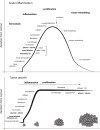Cancer and inflammation
- PMID: 27943646
- PMCID: PMC5561333
- DOI: 10.1002/wsbm.1370
Cancer and inflammation
Abstract
The relationship between inflammation and cancer has been recognized since the 17th century,1 and we now know much about the cells, cytokines and physiological processes that are central to both inflammation and cancer.2-9 Chronic inflammation can induce certain cancers,10-17 and solid tumors, in turn, can initiate and perpetuate local inflammatory processes that foster tumor growth and dissemination.5 ,18-20 Consequently, inflammatory pathways have been targeted in attempts to control cancer.21-23 Inflammation is a central aspect of the innate immune system's response to tissue damage or infection, and also facilitates the recruitment of circulating cells and antibodies of the adaptive immune response to the tissue. Components of the innate immune response carry out a robust, but sometimes overly-conservative response, sacrificing specificity for the sake of preservation. Thus, when innate immunity goes awry, it can have profound implications. How the innate and adaptive immune systems cooperate to neutralize pathogens and repair damaged tissues is still an area of intense investigation. Further, how these systems can respond to cancer, which arises from normal 'self' cells that undergo an oncogenic transformation, has profound implications for cancer therapy. Recently, immunotherapies that activate adaptive immunity have shown unprecedented promise in the clinic, producing durable responses and dramatic increases in survival rate in patients with advanced stage melanoma.24-26 Consequently, the relationship between cancer and inflammation has now returned to the forefront of clinical oncology. WIREs Syst Biol Med 2017, 9:e1370. doi: 10.1002/wsbm.1370 For further resources related to this article, please visit the WIREs website.
© 2016 Wiley Periodicals, Inc.
Figures



References
-
- Abu-Remaileh M, Bender S, Raddatz G, Ansari I, Cohen D, Gutekunst J, Musch T, Linhart H, Breiling A, Pikarsky E, Bergman Y, Lyko F. Chronic inflammation induces a novel epigenetic program that is conserved in intestinal adenomas and in colorectal cancer. Cancer Res. 2015;75:2120–30. - PubMed
-
- Alam M, Khan M, Veledar E, Pongprutthipan M, Flores A, Dubina M, Nodzenski M, Yoo SS. Correlation of Inflammation in Frozen Sections With Site of Nonmelanoma Skin Cancer. JAMA Dermatol. 2016;152:173–6. - PubMed
-
- Alderton GK. Inflammation: the gut takes a toll on liver cancer. Nat Rev Cancer. 2012;12:379. - PubMed
-
- Arthur JC, Perez-Chanona E, Muhlbauer M, Tomkovich S, Uronis JM, Fan TJ, Campbell BJ, Abujamel T, Dogan B, Rogers AB, Rhodes JM, Stintzi A, Simpson KW, Hansen JJ, Keku TO, Fodor AA, Jobin C. Intestinal inflammation targets cancer-inducing activity of the microbiota. Science. 2012;338:120–3. - PMC - PubMed
Publication types
MeSH terms
Substances
Grants and funding
LinkOut - more resources
Full Text Sources
Other Literature Sources

